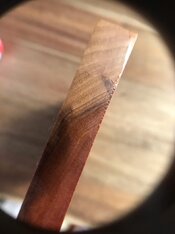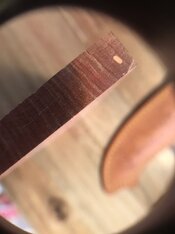Ok in another thread a couple of months ago I discussed the color change of pink ivory and I showed my sample and many people said that it looked very brown.
Well now I managed to get a new sample to compare and they do look a lot different although I do remember my original sample was pink back in the day.... not sure if it was this pink. Well end grain (pink ivory needs more work) looks quite similar I was thinking maybe my sample was actually B. discolor but I would have to get a sample to compare.
Any Guesses or suggestions?
On the right, you can see my sample, and on the left the new sample
First is end grain picture is my original sample and second the new sample



Well now I managed to get a new sample to compare and they do look a lot different although I do remember my original sample was pink back in the day.... not sure if it was this pink. Well end grain (pink ivory needs more work) looks quite similar I was thinking maybe my sample was actually B. discolor but I would have to get a sample to compare.
Any Guesses or suggestions?
On the right, you can see my sample, and on the left the new sample
First is end grain picture is my original sample and second the new sample







